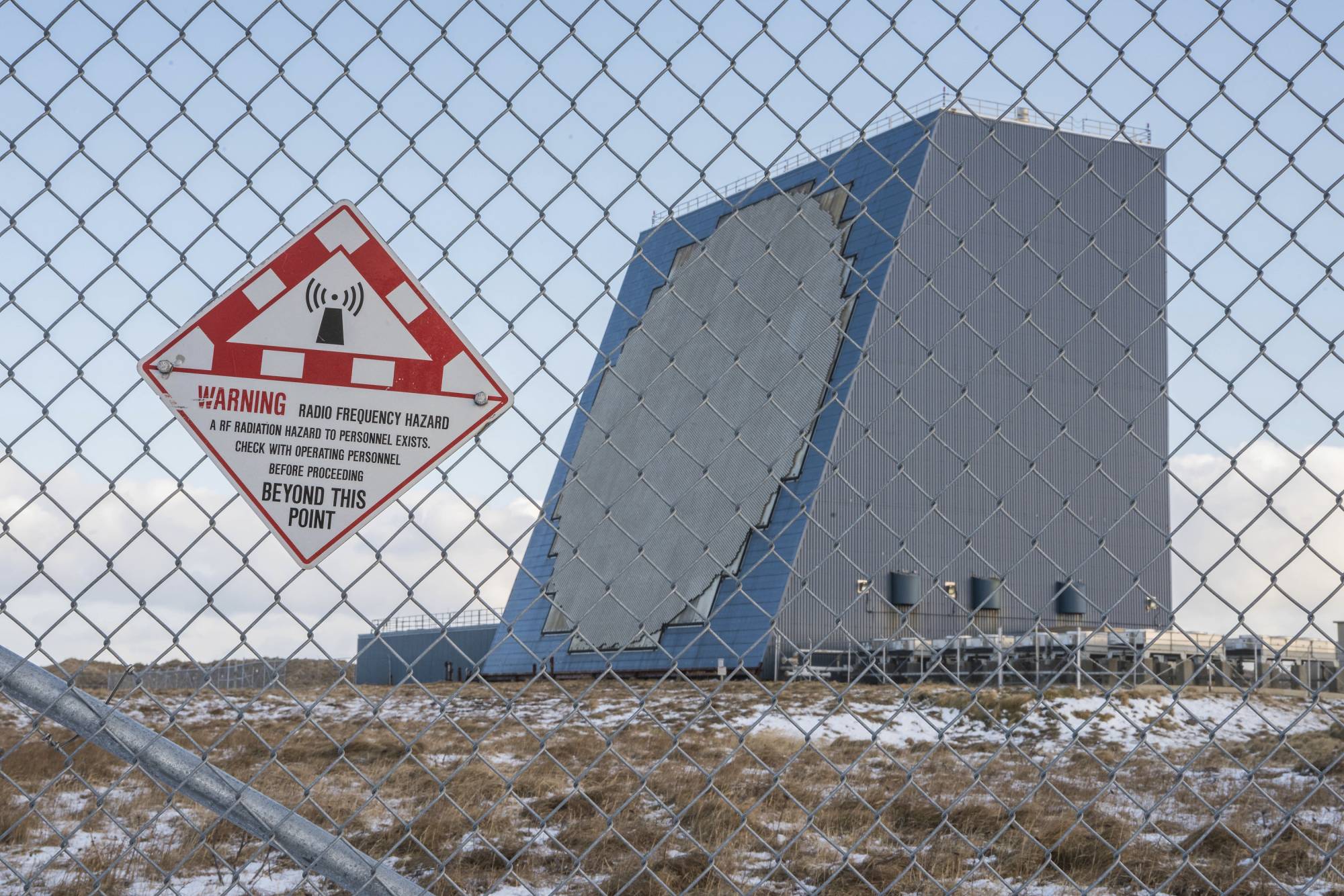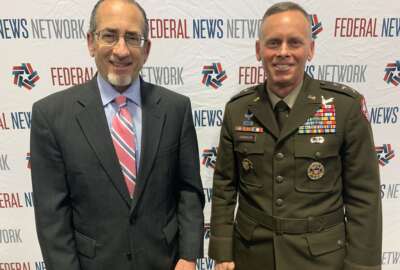The man who’s helping protect Americans from missile attacks from anywhere
Everywhere you look in the world, you see the use of missiles in military operations. Some by good guys, some of it from bad guys. That is why defending against...
Everywhere you look in the world, you see the use of missiles in military operations. Some by good guys, some of it from bad guys. That is why defending against missiles is a chief mission for the Army. For the United States, missile defense and freedom to operate in space go hand-in-hand. At this week’s Association of the U.S. Army conference (AUSA) in Washington, the Federal Drive with Tom Temin got an in-person, one-on-one update from the Commander of the Army Space and Missile Defense Command, Lt. Gen. Daniel Karbler.
Interview Transcript:
Lt. Gen. Daniel Karbler One of my responsibilities, I have the 100th GMD Brigade, which our soldiers that are stationed in Colorado Springs, as well as Alaska, California and Fort Drum, New York. And those soldiers provide 24-7 365 protected North America against intercontinental ballistic missile attacks from North Korea and from Iran. What’s interesting about that formation, it’s a multi compo organization, so it is both active duty as well as Colorado and Alaska National Guard. And they do a fantastic job in keeping readiness, staying vigilant and responding to any kind of North Korea tests that might take place and staying vigilant on consoles. 24-7.
Tom Temin Yeah, that’s my question to as Iran, you know, unfortunately in North Korea, unfortunately and Lord knows who else, China, they’re always developing new capabilities and testing new types of missiles. What is the mechanism by which you can stay on top of what their offensive capabilities are? So the defensive capabilities here can keep up?
Lt. Gen. Daniel Karbler Sure. Yeah. We stay very, very closely tied with the Missile Defense Agency. So as we see what the threat is doing out there and what our adversaries are doing with respect to their advances in offensive missile capabilities. The Missile Defense Agency is responsive to meeting those new requirements. And then they worked very they worked very closely with my operators. I mean, literally, we sit side by side with the engineers as we’re going through the different development, software development, etc., to make sure that the Missile Defense Agency doesn’t develop something then that the operators aren’t totally familiar with. And then that’s on the software side. And then Missile Defense Agency right now is going through the development of the next generation interceptor, which again, they involve our operators in as they go through developing the NGI.
Tom Temin Right and the interceptor program. Can that handle say, I mean, what’s the posture towards hypersonics, which are even developmental by the other nations, but that seems to be where people are headed.
Lt. Gen. Daniel Karbler Yes. So, again, MDA is working super hard on, first off, being able to detect hypersonics. If you can’t see it, you can’t shoot it. And so working with the HBTSS, the hypersonic ballistic, basically our space based layer that we have to be able to track hypersonics, then that will feed into the interceptor capabilities that we will that they will continue to work on developing and our operators will be the ones that employ it.
Tom Temin Yeah, it’s like the difference between a knuckleball and a hundred mile an hour fastball. Some better say they never see it go by, so you got to see it before you can swing at it.
Lt. Gen. Daniel Karbler Right? Right.
Tom Temin And you’re tied in closely with the space operation, the space apparatus for the military. How does that work?
Lt. Gen. Daniel Karbler Yes. So I’m the Army service component command to General Jim Dickinson, the SpaceCom commander. We’ve been doing that since really since the advent of Space Command in 2019. And in that role I have for Space Brigade, we provide forces to space command and we work very closely with the Space Force as well as with the Navy and the Marine Corps in providing different service space capabilities to space command for operational employment. We use them in exercises. I have a little bit of convergence of space and missile defense. If I jump out of my space, the missile Defense Command commander responsibility into my joint functional component command for integrated missile defense, there’s also work that we’re doing IMD armed with Space Command, as you might be aware of in the latest unified command plan, it took the missile defense responsibility out from underneath strategic Command and its placed trans regional missile defense capability, mission responsibilities underneath U.S. Space Command, trans regional.
Tom Temin Coming from outside of the United States, basically, or.
Lt. Gen. Daniel Karbler Going from one AOR to another. Got it. And so it used to be global missile defense, which was not a very accurate description really, of what the mission said and what we were facing. It was trans regional missile defense. And in this made a lot of sense because General Dickinson in Space Command has responsibility, the global sensor manager. Well, many of our sensors that we have that we use for missile defense, they also are able to do space domain awareness. And so instead of arbitrating between STRATCOM and Space Command about use of these sensors, putting them all up underneath one combat command solves a unit of effort year command and makes me responsive then to just one combat command. Not that we ever had fistfights or anything between the two combat commanders, but it just makes it easier for us to put it up underneath one commander.
Tom Temin And the new term now is missile defeat as opposed to just missile defense. What is the difference in how do you envision that?
Lt. Gen. Daniel Karbler Yeah, so how I envision a missile defeat is if you picture the traditional missile defense, where it’s active defense, where you see the Patriot and you see that or EGIS BMD ships that are doing that active defense piece, and there’s also some passive defense early warning that’s part of the traditional integrated air missile defense and even attack ops that’s traditional integrated air and missile defense. But then you take a look at what we’re doing for left of launch capabilities. So before that missile gets off, gets off the rails, gets off the tail, gets out of a silo that left of launch capability so we could deny and disrupt those capabilities before they launch altogether becomes a missile defeat. And what we’re trying to do is, is we’ve been working and through a couple of different exercises, establishing a missile to feed effects coordinator. So somebody who’s responsible for taking that that whole vision that I just told you about and an exercise in that. And so in a previous exercise with Space Command, we’ve been rolling out this missile defeat effects coordinator concept in and frankly, you know, test driving it a little bit.
Tom Temin Yeah. So to kill a missile that would ordinarily come within the airspace say and you have to defend against it to defeat it on the ground or originate that’s not really missile defense command. That would be somebody else that would shoot something at it.
Lt. Gen. Daniel Karbler Right in the missile defeat effects coordinator. That’s the one who identifies the threat and is able to then influence maybe another COCOM to say, hey, here’s where your targeting should be after. Maybe there’s not kinetic effects that we can apply to that solution.
Tom Temin Yeah. So that that’s where you get back to the need for the space view, because that’s where the original knowledge of such a launch would originate in the first place.
Lt. Gen. Daniel Karbler Likely, right?
Tom Temin I guess there are maybe people on the ground in some of the areas, but I mean something.
Lt. Gen. Daniel Karbler Yeah. And some of the geographical embankments we have that they have the intel and they they’re well aware of what the adversary missile order battle is. But again, a missile defeat effects coordinator can help work that really holistically across combat commands again, because it’s a Trans regional missile threat.
Tom Temin Yeah. So there’s really an update in doctrine and an update in command structure for you in recent times. What does that have? What’s the effect of that on workforce and what you need for talent?
Lt. Gen. Daniel Karbler Yeah, so as we’re as we’re practicing these exercises this notion it’s it it’s really been it’s a good challenge because it’s a new approach. And as my IMD staff has been working with the Space.com staff, traditionally Space.com staff, you know, they really focus on, you know, space and on orbit and in the space capabilities. Well, now we’ve brought missile defense, Trans regional missile defense requirement into them. So it’s been a good opportunity for us to exercise and integrate with our staff in that new mission set for Space Command.
Tom Temin Yeah. And the concept of the Army astronaut, that has emerged, too, and that’s not a two words that you often hear conflated. But now, now it’s a thing.
Lt. Gen. Daniel Karbler Yeah, it sure is. We couldn’t be prouder of Frank Rubio, Lieutenant Colonel Promotable. Frank Rubio, one of my Army astronauts who just returned from the International Space Station. And, you know, he’s been in the news here quite a bit lately. He set the record for an American astronaut in space, 371 days.
Tom Temin That’s more than a year.
Lt. Gen. Daniel Karbler Ago. That’s more than he has. He spent more than a year in space and he returned safe and sound. I had a chance to chat with him and catch up with him this past weekend and ask him how he’s doing as recovering. Get used to gravity again.
Tom Temin And how’s this bone density?
Lt. Gen. Daniel Karbler His bone density is it’s getting there. You know, as you would expect, NASA runs an incredible number of tests on him. And he didn’t call himself the lab rat, but he’s kind of he’s a very good test case for NASA right now. But so as they do the testing on him and then rehabbing him to get him, you know, back to where he needs to be, you know, in the Earth’s environment. He’s in great spirits. He’s glad to be home. He missed a couple of key family events in that unexpected year. You know, that additional time.
Tom Temin The additional time was because of the failure of a launch to get to the space station.
Lt. Gen. Daniel Karbler What happened was they had what they assumed was micrometeorites had damaged the cooling system on the recovery on the return vehicle. So NASA’s had to send out, Russia, sent up a replacement vehicle, but it took them six months to stay on station before he and his other his Russian crewmates could return. And so but like a good soldier, he soldiered on. You know, he was extended a lot of soldiers. He had extended on deployments. Frank was just a different type of extension on his deployment in a different domain.
Tom Temin Got it.
Lt. Gen. Daniel Karbler Super proud of him.
Tom Temin And you had three Army astronauts graduated from.
Lt. Gen. Daniel Karbler From West Point. Yeah. So Drew Morgan, he’s the commander right now Kwajalein Atoll really at all. So I’m the senior commander responsible for KWAJ, which is out there in the South Pacific, does a lot of our strategic missions with space fence out there, does sports, all the testing for Reagan test site, for intercontinental ballistic missile tests and other missile defense tests that we do there. Drew has taken over command of that just this past summer. And then Ann McClain, who is in NASA right now. She just competed in the brigade command assessment program. She wants to go on and become an army brigade commander.
Copyright © 2025 Federal News Network. All rights reserved. This website is not intended for users located within the European Economic Area.
Tom Temin is host of the Federal Drive and has been providing insight on federal technology and management issues for more than 30 years.
Follow @tteminWFED






